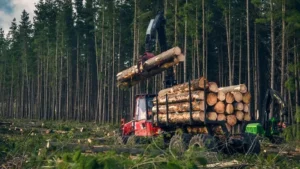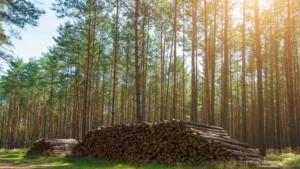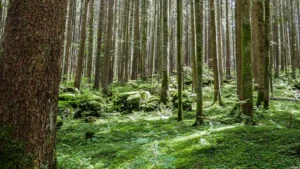Responsible Timber Industry: Embracing Sustainable Practices
- September 18, 2024
- 0 comment
Sustainability has become the cornerstone of various industries, but none is more critical than the timber sector. The timber industry has long been a pillar of global trade, providing essential materials for construction, furniture, paper, and more.

However, concerns surrounding deforestation, biodiversity loss, and climate change have pushed the need for a more responsible and sustainable approach to timber production.
“Embracing Sustainability: Paving the Way for a Responsible Timber Industry” captures the essence of this pivotal moment in the timber sector’s transformation. By integrating sustainable practices, the industry can support environmental conservation while meeting the world’s growing demand for wood.
The Environmental Impact of Timber Harvesting
The environmental concerns surrounding timber harvesting are significant, ranging from deforestation to soil erosion and carbon emissions. Deforestation, driven in large part by the global demand for wood and land, leads to habitat loss and threatens biodiversity. This disruption to ecosystems exacerbates climate change by reducing the number of trees capable of absorbing carbon dioxide from the atmosphere.
Moreover, irresponsible logging practices can result in the degradation of forest soils, leading to reduced fertility and increased erosion. This not only affects the immediate area but also has downstream impacts on water systems, agricultural productivity, and local communities.
The Importance of Forest Stewardship
Forest stewardship, which emphasizes responsible forest management, is central to the idea of sustainability in the timber industry. The Forest Stewardship Council (FSC) is a leading organization that certifies timber producers who adhere to stringent environmental and social standards.

By promoting responsible harvesting, ensuring the protection of indigenous rights, and maintaining the ecological balance, forest stewardship helps mitigate the adverse effects of timber extraction.
Certifications such as FSC’s are critical in ensuring that timber production aligns with environmental goals. Consumers and businesses are increasingly demanding certified wood products, incentivizing companies to adopt responsible forestry practices.
Sustainable Forestry Management Practices
Sustainable forestry management (SFM) refers to practices that maintain the health of forest ecosystems while allowing for timber extraction. SFM involves selective logging, where only certain trees are harvested to ensure the forest’s regeneration. By leaving behind younger trees and reducing damage to surrounding vegetation, selective logging supports forest recovery and maintains biodiversity.

- Selective Logging: Harvests specific trees to allow forest regeneration and maintain biodiversity.
- Reforestation: Planting trees in deforested areas to restore ecosystems.
- Afforestation: Establishing forests in previously non-forested regions for environmental and economic benefits.
- Controlled Burning: Reduces underbrush and prevents wildfires while promoting new growth.
- Ecosystem-based Management: Balances timber production with preserving the health of the forest ecosystem.
In addition to selective logging, reforestation and afforestation initiatives are crucial. Reforestation involves planting trees in areas that have been deforested, while afforestation refers to establishing forests in previously non-forested regions. Both practices help sequester carbon, restore ecosystems, and contribute to the long-term sustainability of the timber industry.
Innovations in Timber Production
Technological advancements are playing a significant role in making the timber industry more sustainable. Drones and satellite imagery, for example, are being used to monitor forest health and track illegal logging activities. These tools provide real-time data that allow for better forest management and protection of endangered species.

| Innovation | Benefit | Efficiency Gain (%) | Environmental Impact |
|---|---|---|---|
| Cross-Laminated Timber (CLT) | Reduces carbon footprint in construction | 30% | Lower emissions |
| Drones for Forest Monitoring | Tracks deforestation and illegal logging | 25% | Improved forest protection |
| Engineered Wood Products | Strengthens material, reduces waste | 20% | Decreased resource use |
| Blockchain in Supply Chain | Ensures traceability of timber | 15% | Enhanced sustainability |
| Satellite Imagery | Provides real-time forest data | 35% | Better resource management |
Another innovation is the development of engineered wood products, such as cross-laminated timber (CLT). CLT is made by layering pieces of wood in different directions, creating a strong and durable material that can be used in construction. The production of CLT uses less energy than steel or concrete, and it sequesters carbon, making it a more environmentally friendly building material.
The Role of Policy and Regulation
Government policies and regulations are essential to promoting sustainable practices within the timber industry. Many countries have enacted laws to combat illegal logging, which accounts for a significant portion of deforestation globally. For instance, the European Union’s Timber Regulation and the United States’ Lacey Act require companies to ensure that their timber is sourced legally and sustainably.
| Policy/Regulation | Purpose | Impact on Sustainability | Compliance Rate (%) | Global Reach |
|---|---|---|---|---|
| EU Timber Regulation | Prevents illegal timber imports | High | 85% | International |
| Lacey Act (USA) | Bans illegal wood trade | Moderate | 75% | National/Global |
| Paris Agreement | Reduces deforestation-related emissions | Significant | 70% | Global |
| Forest Certification Standards | Promotes responsible forestry | High | 80% | Global |
| National Forestry Policies | Protects local forest ecosystems | Varies | 60% | National |
International agreements, such as the Paris Agreement, also emphasize the importance of sustainable land use and forest conservation. By reducing emissions from deforestation and forest degradation, the timber industry can contribute to global climate goals.
Challenges in Achieving Sustainability
Despite the advancements in sustainable timber practices, several challenges remain. One of the biggest obstacles is the profitability of illegal logging. In many regions, weak governance and corruption enable illegal loggers to operate with impunity, undermining efforts to promote sustainable forestry.

Another challenge is the economic pressure faced by timber-producing countries. Many developing nations rely heavily on timber exports as a source of revenue, making it difficult to prioritize sustainability over short-term economic gains. Balancing economic growth with environmental protection is a complex issue that requires coordinated efforts from governments, businesses, and civil society.
The Role of Consumers in Promoting Sustainability
Consumers play a pivotal role in driving sustainability in the timber industry. By choosing certified wood products and supporting companies that prioritize environmental and social responsibility, consumers can influence market demand and encourage more sustainable practices.
- Choose Certified Products: Opt for FSC or PEFC-certified wood products to support sustainable forest management.
- Educate Themselves: Stay informed about the environmental impacts of timber sourcing.
- Support Ethical Companies: Buy from businesses that prioritize responsible forestry practices.
- Advocate for Change: Encourage companies and policymakers to adopt stronger sustainability measures.
- Reduce, Reuse, Recycle: Minimize wood waste by reusing and recycling wood products whenever possible.
Public awareness campaigns and education initiatives are essential in helping consumers understand the environmental impact of their purchasing decisions. As more people become conscious of the link between deforestation and climate change, the demand for sustainably sourced timber is expected to rise.
Corporate Responsibility and Ethical Sourcing
Many companies within the timber industry have embraced corporate responsibility as part of their business strategy. Ethical sourcing of wood involves ensuring that products are obtained from forests managed in a way that preserves biodiversity, respects indigenous communities, and promotes forest regeneration.
| Area | Impact | Sustainability Score (out of 10) | Improvement Potential (%) |
|---|---|---|---|
| Certified Wood Sourcing | Reduces deforestation | 8/10 | 15% |
| Consumer Awareness Campaigns | Promotes eco-friendly purchasing | 7/10 | 20% |
| Supply Chain Transparency | Ensures ethical logging practices | 9/10 | 10% |
| Corporate Carbon Footprint | Lowers emissions through sustainable practices | 6/10 | 25% |
| Community Engagement | Supports local, indigenous communities | 7/10 | 18% |
Businesses that adopt sustainable practices not only contribute to environmental protection but also benefit from enhanced brand reputation and consumer trust. Companies that fail to prioritize sustainability may face backlash from increasingly environmentally conscious consumers and investors.
The Economic Benefits of Sustainable Timber
Sustainability is not just an environmental concern; it also has economic benefits. Responsible timber production ensures the long-term availability of forest resources, supporting the industry’s future growth. In contrast, unsustainable practices can lead to resource depletion, threatening the industry’s viability.
- Long-term Resource Availability: Ensures forests can continue to provide wood for future generations.
- Increased Market Demand: Growing consumer interest in eco-friendly products boosts sales of certified timber.
- Enhanced Brand Reputation: Companies with sustainable practices attract more customers and investors.
- Cost Savings: Efficient resource use and reduced waste lower production costs over time.
- Job Creation: Sustainable forestry supports green jobs, from forest management to eco-certification services.
Moreover, the shift towards sustainable timber production has created new economic opportunities. The demand for certified wood products is growing, and companies that can meet this demand are well-positioned to capture a share of the emerging green economy.
Collaboration for a Sustainable Future
Achieving sustainability in the timber industry requires collaboration among governments, businesses, NGOs, and local communities. Public-private partnerships are crucial in developing and implementing sustainable forestry initiatives, such as reforestation projects and the enforcement of anti-illegal logging laws.

International organizations, such as the United Nations and the World Wildlife Fund, play a key role in supporting global efforts to protect forests and promote sustainable land use. By working together, stakeholders can ensure that the timber industry contributes to environmental conservation and sustainable development.
Sustainable Timber and Climate Change
Forests play a critical role in mitigating climate change by acting as carbon sinks. Sustainable timber production helps preserve this function by ensuring that forests continue to absorb carbon dioxide. In contrast, deforestation and unsustainable logging practices release stored carbon into the atmosphere, exacerbating global warming.

- Carbon Sequestration: Forests absorb CO2, reducing greenhouse gases.
- Reduced Deforestation: Sustainable timber practices protect forests from overharvesting.
- Lower Emissions: Eco-friendly timber production cuts down carbon output.
- Forest Resilience: Healthy forests better withstand climate impacts.
- Biodiversity Conservation: Supports species that help regulate climate.
- Renewable Resource: Timber is a sustainable, low-carbon alternative to concrete or steel.
- Reforestation Initiatives: Restores degraded areas, increasing carbon sinks.
- Circular Economy: Encourages wood reuse and recycling, reducing waste.
The timber industry has the potential to be part of the solution to climate change by adopting practices that enhance forest resilience and reduce emissions. Forest-based carbon offset programs, for example, allow companies to compensate for their emissions by investing in reforestation and forest conservation projects.
Future Trends in the Timber Industry
Looking ahead, the timber industry is expected to continue its shift towards sustainability. Innovations in technology, such as artificial intelligence and blockchain, could further improve supply chain transparency and forest management. These tools can help track the origin of timber products and ensure that they are sourced responsibly.
Additionally, the rise of the circular economy presents new opportunities for the timber industry. The circular economy emphasizes the reuse and recycling of materials, reducing the need for new timber and minimizing waste. By embracing circular economy principles, the timber industry can reduce its environmental footprint and contribute to sustainable development.
Final Conclusion
The future of the timber industry lies in sustainability. By adopting responsible forestry practices, embracing technological innovations, and prioritizing ethical sourcing, the industry can play a vital role in environmental conservation and climate change mitigation. Consumers, businesses, and governments all have a part to play in promoting a more sustainable timber industry. Through collaboration and commitment, the industry can meet the world’s demand for wood while protecting the planet’s precious forest ecosystems for generations to come.
Frequently Asked Questions (FAQs)
- Why is sustainability crucial in the timber industry?
Sustainability in the timber industry is essential to mitigate deforestation, protect biodiversity, and reduce carbon emissions. By embracing sustainable practices, the industry ensures long-term environmental health, maintains forest ecosystems, and supports climate change mitigation. It also helps meet consumer demand for eco-friendly products. - What is the role of forest stewardship in promoting responsible timber production?
Forest stewardship emphasizes responsible management of forest resources by ensuring sustainable harvesting, protecting indigenous communities, and maintaining biodiversity. Certifications like those from the Forest Stewardship Council (FSC) set standards that timber companies must follow to meet environmental and social sustainability requirements, encouraging responsible forestry. - What are some sustainable forestry management practices?
Sustainable forestry management (SFM) practices include selective logging, which preserves younger trees and reduces ecosystem damage, reforestation to restore deforested areas, and afforestation in non-forested regions. These practices maintain forest health, support biodiversity, and ensure long-term timber availability. - How do technological innovations support sustainability in the timber industry?
Technologies like drones, satellite imagery, and engineered wood products (e.g., cross-laminated timber) are revolutionizing timber production. These technologies enable precise forest monitoring, deter illegal logging, and reduce carbon emissions by creating energy-efficient, durable wood products. - How do policies and regulations influence sustainable timber practices?
Government policies like the EU Timber Regulation and the U.S. Lacey Act ensure that timber is sourced sustainably and legally. These regulations, alongside international agreements like the Paris Agreement, promote forest conservation and discourage illegal logging, aligning timber practices with climate change goals. - What are the challenges to achieving sustainability in the timber sector?
Key challenges include illegal logging, economic dependence on timber in developing countries, and weak governance. These issues hinder progress toward sustainable practices as short-term profits often overshadow long-term environmental protection. - What role do consumers play in promoting sustainable timber?
Consumers drive sustainability by choosing certified, responsibly sourced wood products. Public awareness campaigns educate consumers on the environmental impacts of their choices, encouraging them to support companies that prioritize sustainability. Increased demand for sustainable products pushes the industry towards responsible practices. - What is corporate responsibility in the timber industry?
Corporate responsibility involves businesses adopting ethical sourcing of timber, ensuring that wood is harvested sustainably, and preserving forest ecosystems. Companies that prioritize corporate responsibility gain consumer trust and align with growing environmental and social expectations. - How does sustainable timber production contribute to economic growth?
Sustainable practices ensure the long-term viability of forests, supporting ongoing timber production and creating new economic opportunities, especially in the green economy. Companies that produce certified, eco-friendly products attract environmentally conscious consumers and investors. - What future trends are expected in the timber industry?
The timber industry is expected to continue embracing sustainability with advancements in AI, blockchain for supply chain transparency, and a shift toward the circular economy. These trends will reduce waste, improve forest management, and strengthen the industry’s commitment to sustainable development.
We hope this article has shed light on the critical role sustainability plays in shaping a responsible timber industry. Have any personal experiences or insights on promoting sustainable forestry? Share your thoughts and join the conversation below. Your contributions can help raise awareness and inspire more sustainable practices within the industry. Don’t forget to share this article with others who are passionate about protecting our forests and ensuring a greener future for all.

Edward Smith
Forestry AuthorWoodworking is about more than crafting; it's a harmonious connection with nature, mastering tools, and preserving our environment. I'm here to share my knowledge and experiences with you, forging a future where we can embrace wood's beauty and utility while safeguarding our forests' health and diversity.












Leave your comment